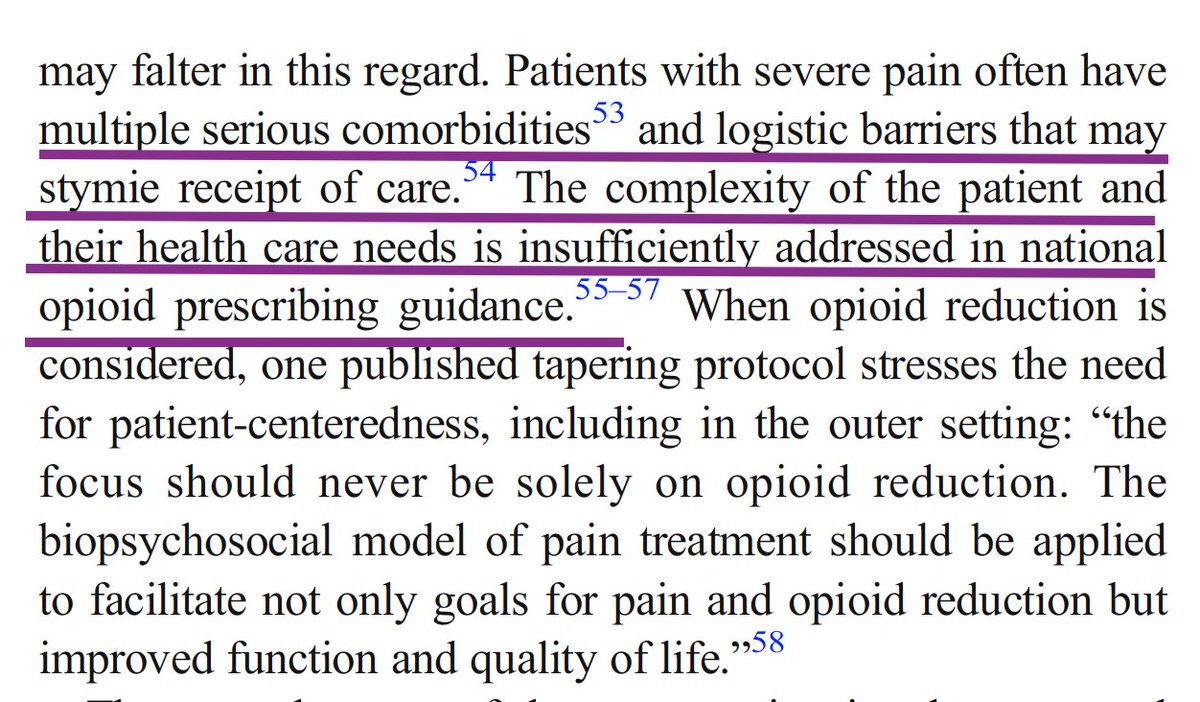1/This week in @journaljgim: “Promoting Patient-Centeredness in #opioid Deprescribing: a Blueprint for De-implementation Science”
Tools of “deimplementation science” should guide evaluation of health care changes - w/ @BethDarnall @AllysonVarley
https://link.springer.com/article/10.1007/s11606-020-06254-7
Tools of “deimplementation science” should guide evaluation of health care changes - w/ @BethDarnall @AllysonVarley
https://link.springer.com/article/10.1007/s11606-020-06254-7
2/Opioid prescribing has  37% since its peak in 2011. Today, many agencies agree that “deprescribing” was not carried out in ways that consistently protected patients.
37% since its peak in 2011. Today, many agencies agree that “deprescribing” was not carried out in ways that consistently protected patients.
We ask “how can well-intended changes to care transpire in ways that are unsafe or harmful?”
 37% since its peak in 2011. Today, many agencies agree that “deprescribing” was not carried out in ways that consistently protected patients.
37% since its peak in 2011. Today, many agencies agree that “deprescribing” was not carried out in ways that consistently protected patients. We ask “how can well-intended changes to care transpire in ways that are unsafe or harmful?”
3/De-implementation= “reducing or stopping practices that are ineffective, unproven, harmful, overused, or inappropriate”
With opioids, that could be not starting, stopping or reducing.For us, this does *not* reflect a commitment to opioid elimination from care.h/t @VPrasadMDMPH
With opioids, that could be not starting, stopping or reducing.For us, this does *not* reflect a commitment to opioid elimination from care.h/t @VPrasadMDMPH
4/Implementation scientists ask: “how and why efforts to change health care delivery succeed or fail.
It's *not enough* to ask whether prescriptions have declined
*It's better to ask "how reductions were made to happen and what the impact was on patients with pain” #ChronicPain
It's *not enough* to ask whether prescriptions have declined
*It's better to ask "how reductions were made to happen and what the impact was on patients with pain” #ChronicPain
5/Headlines, press releases, news coverage on Rx opioids treat "pill count dynamics" as the be-all & end-all
To us, a change to care is worth it only if carried out in such a way as to achieve protection of patients. That principle is honored mostly in the breach, sadly
To us, a change to care is worth it only if carried out in such a way as to achieve protection of patients. That principle is honored mostly in the breach, sadly
6/But we have tools to do better. Scientists who study healthcare system change assess those efforts by looking at 5 domains from a model called “Consolidated Framework for Implementation Research”.
Let's walk this through with opioid Rx's #CFIR https://cfirguide.org
Let's walk this through with opioid Rx's #CFIR https://cfirguide.org
7/Domain 1: Characteristics of Individuals – this includes professionals’ training in pain care, comfort with patients, and their ability to withstand external professional pressures and more https://cfirguide.org/constructs/characteristics-of-individuals/
Our studies ignore this at their peril
Our studies ignore this at their peril
8/Domain 2 of #CFIR is the Intervention: “What letters, orders, policies, resources, supports, or other actions were used to change pain care & opioid prescribing?"–reporters & scholars leaders should ALWAYS report if their interventions were across the board or *individualized*
9/Domain 3 is "Inner Setting":organizational culture.
Do leaders use threats or rewards to opioid Rx's?
opioid Rx's?
Does the culture of an organization permit safe expression of concern about harm to patients?
In a @TEDx talk, a leader rebuffed suicide concerns
Do leaders use threats or rewards to
 opioid Rx's?
opioid Rx's? Does the culture of an organization permit safe expression of concern about harm to patients?
In a @TEDx talk, a leader rebuffed suicide concerns
10/Domain 4 of #CFIR is Process: what health care changes were carried out? what resources allocated?Who was consulted? & how the process was changed? Much of today’s research & journalistic reporting tell only about “pill dynamics”, i.e. “too much!” “too little!”
11/Domain 5 of #CFIR is Outer Setting. In part this domain asks to what extent is a planned change to care delivery is aligned with the needs and context of the patients we wish to serve, including disability & logistics!
12/ The Outer Setting also includes *external policies*, including quality metrics from @NCQA, thresholds for payment decisions tied to 90 MME. Most ignore CDC Guideline’s distinction between doses forced down vs not escalated, and ignore the clarifications from CDC and HHS.
13/A warning: external policies are NEVER completely rational, for 2 reasons
1]decision-makers cannot fully absorb problems they are called upon to solve (“bounded rationality”).
2]policy is not put into effect by one party, but many, including regulators, even journalists
1]decision-makers cannot fully absorb problems they are called upon to solve (“bounded rationality”).
2]policy is not put into effect by one party, but many, including regulators, even journalists
14/We offer a better slate of measures of success (for successful de-implementation). It’s not sufficient to just ask how many fewer opioid prescriptions are written. We offer "better metrics" for health systems & insurers and @NCQA
15/"Implementation science points toward a
reappraisal of how our health system responses to the opioid crisis can become more effective, holistic, and patient centered."
We're proud to be part of @vahsrd @StanfordPain @UMass @UABNews
Read more here: https://link.springer.com/article/10.1007/s11606-020-06254-7
reappraisal of how our health system responses to the opioid crisis can become more effective, holistic, and patient centered."
We're proud to be part of @vahsrd @StanfordPain @UMass @UABNews
Read more here: https://link.springer.com/article/10.1007/s11606-020-06254-7

 Read on Twitter
Read on Twitter







![13/A warning: external policies are NEVER completely rational, for 2 reasons1]decision-makers cannot fully absorb problems they are called upon to solve (“bounded rationality”). 2]policy is not put into effect by one party, but many, including regulators, even journalists 13/A warning: external policies are NEVER completely rational, for 2 reasons1]decision-makers cannot fully absorb problems they are called upon to solve (“bounded rationality”). 2]policy is not put into effect by one party, but many, including regulators, even journalists](https://pbs.twimg.com/media/EpSehvDWEAM9gbD.png)



